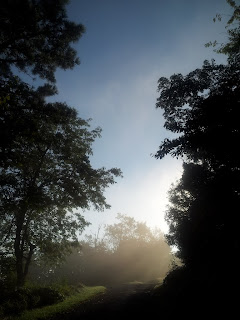On September 8, we braved a “sunny and 80s” forecast with
our third trip to Harpers Ferry, this time to hike up the popular trail to Maryland
Heights. The town of Harpers Ferry dates from the 1790s and has a very rich
history (Civil War and pre-Civil War) in an exceptionally scenic setting where
the Shenandoah River spills into the Potomac. An old railroad bridge over the
latter (now part of the Appalachian Trail) and high cliffs above offer dramatic
views and it was time we got us some. We rolled into town mid-morning and
rambled a bit before heading across the bridge, briefly along the C&O
Canal, and up the steep trail to the Heights.
23. Maryland Heights: The trail climbs steadily, passing historic
gun placements where canons up to 5 tons were hauled up the mountain by Union soldiers
to defend the area from incursions by the South. The biggest guns could lob a 100-pound slug more than two miles. But after being turned away
once, the Confederates succeeded in routing the Yanks and many were killed, with
thousands taken captive. There is too much history to pretend to summarize
here, but Harpers Ferry was very much in the thick of it, essentially located on
the line between the North and South. Plus, there’s the great story of John
Brown who, shortly before the war, was determined to end slavery with a rag-tag
mini-infantry under the cover of darkness, if only he could. I highly recommend
the recent book, Midnight Rising, by Tony Horwitz, as not only a gripping
biography of Mr. Brown, but a wonderful lead-up to the inevitability of a Civil
War.
A spur path led us down to the overlook atop the cliff with
the million-dollar view of Harpers Ferry. From there, it was another steady
gain to the ridge top and easier ground leading to the remains of a stone fort
and the gentle summit of Maryland Heights. Three states, interestingly, converge near Harpers Ferry.
We’d left DC in the morning, drove through Virginia, landed in West Virginia
and hiked sweatily into Maryland. On the return, the river demanded we stop and
soak our feet a spell. Next time, we’ll remember the sandals since the river is
quite wadable, though the gravel bottom is tough to walk on with dainty feet
like mine. However, large flat rocks do lay just yards off the bank, passing
time till some lazy hikers come out to sit on them. Flocks of tubes and rafts
also drifted by. That’s a kind of lazy we’re going to have to get penciled
in on the calendar before these 80-degree, late-summer days are all used up.
Miles (RT): 6.0
miles; elevation gain: 1,600 feet
Cumulative mileage and gain:
107.5 miles / 30,450 feet
 |
| A lizard hides in plain sight. |
 |
| The stone fort. |
 |
| Kris bags the summit. |
 |
| The mighty Potomac. |






























